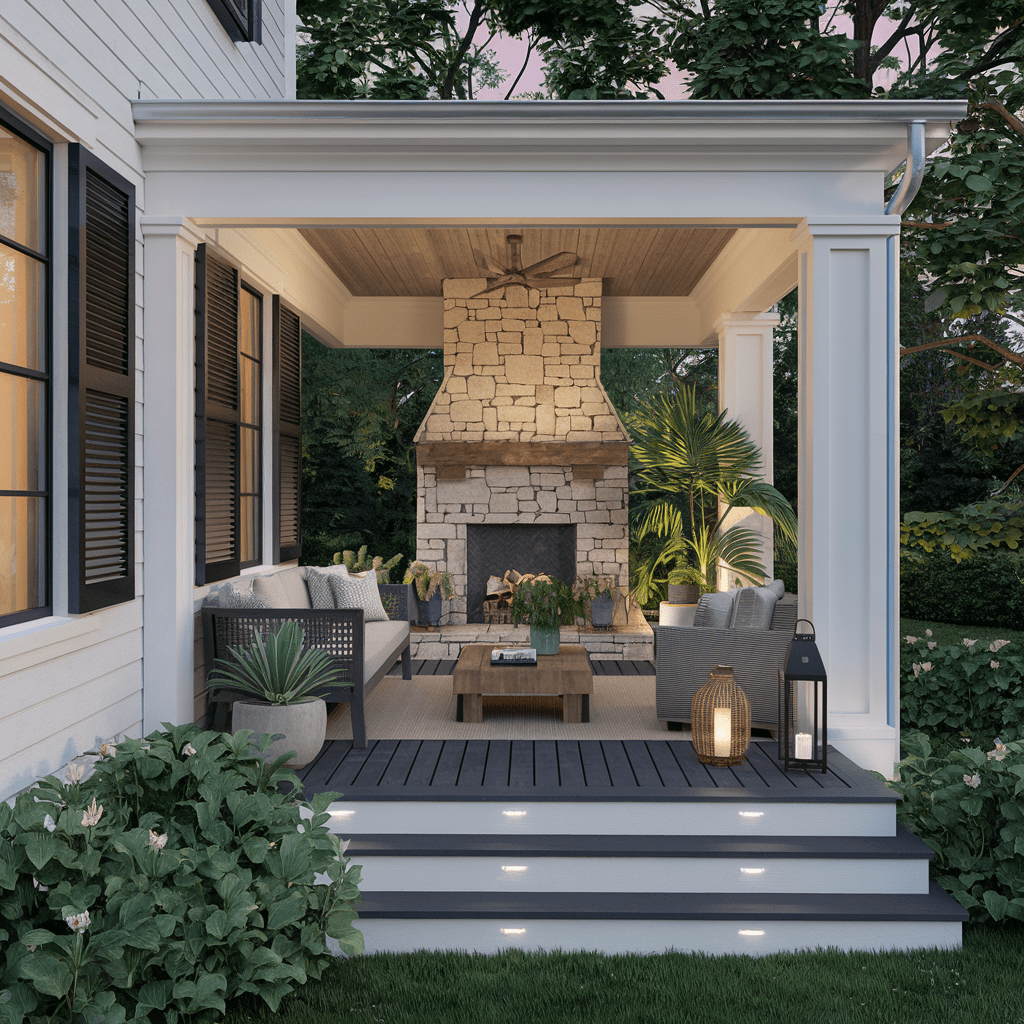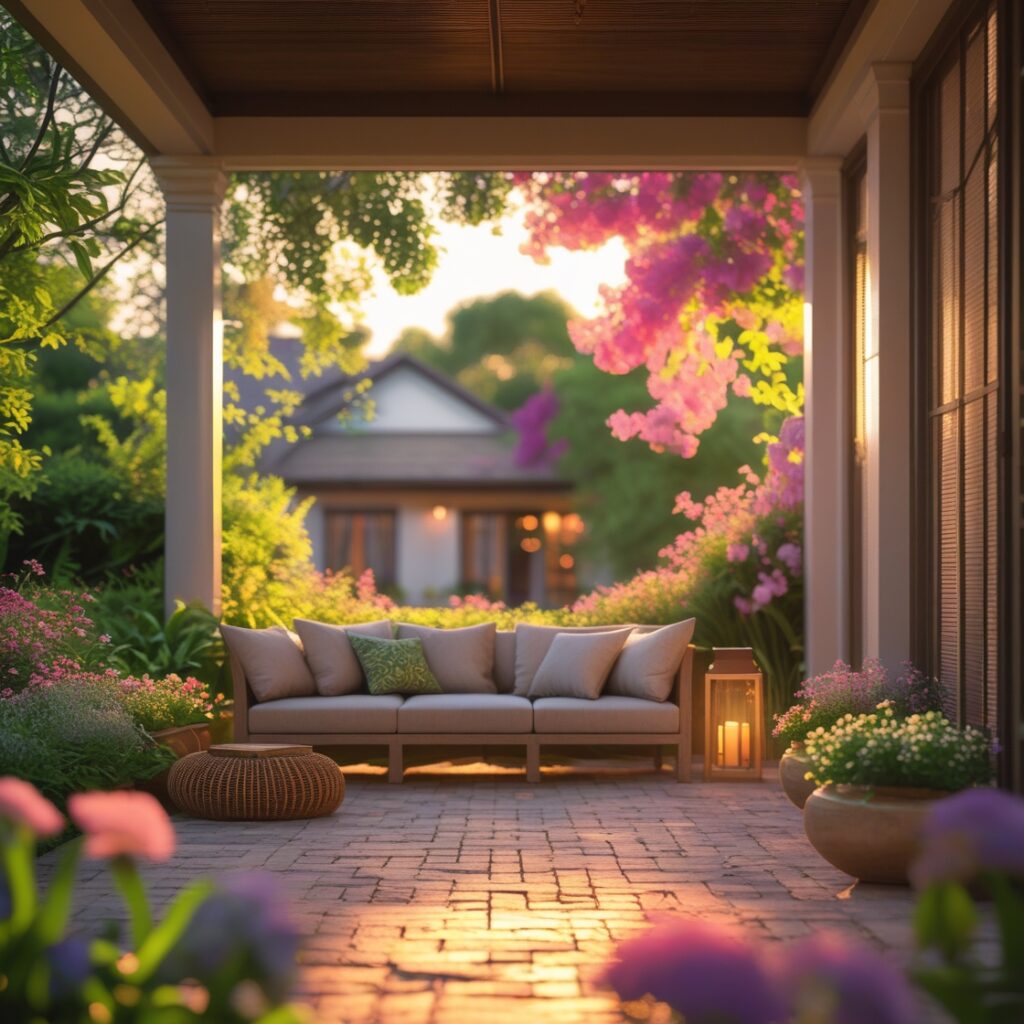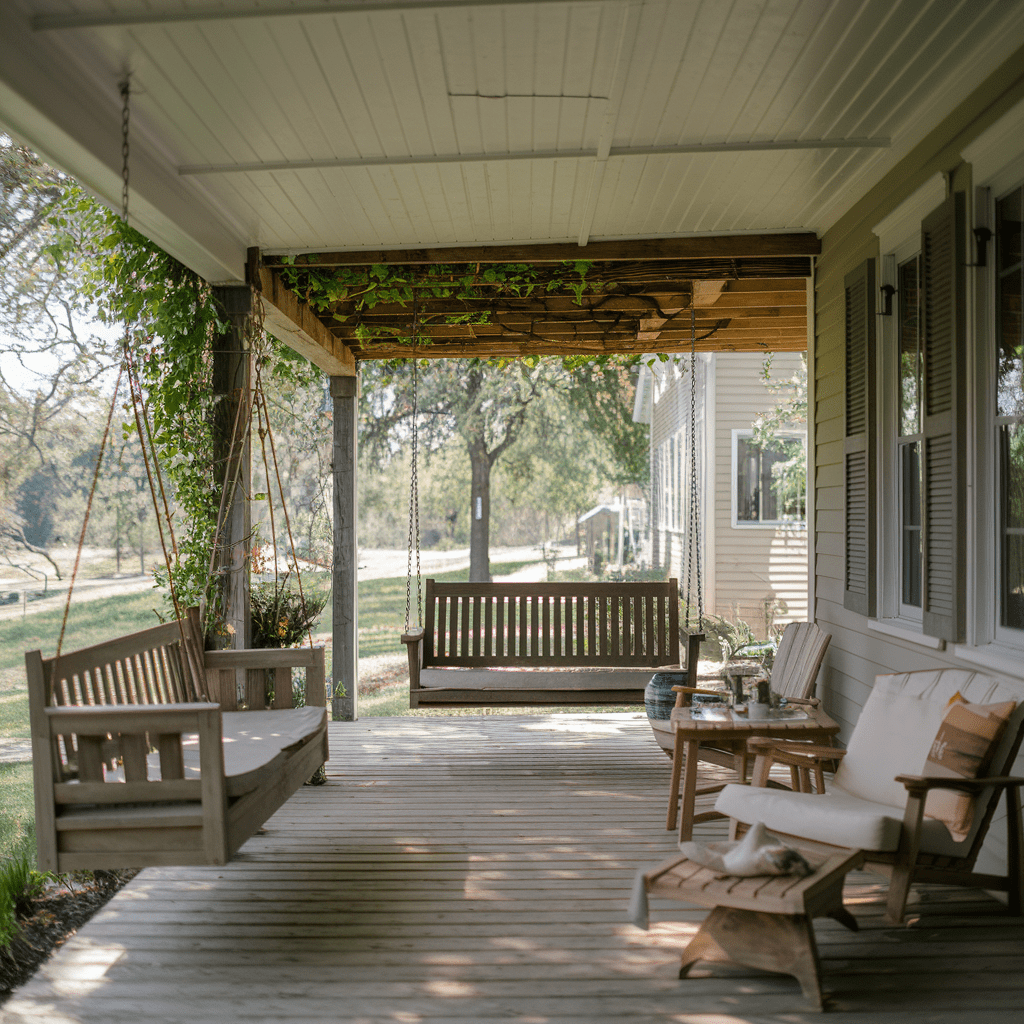
Introduction to Patios and Porches
Patios and porches have long been recognized as essential elements in home design, offering not only aesthetic appeal but also functional outdoor living spaces. Historically, patios date back to ancient civilizations, serving as open areas adjacent to buildings for relaxation, gatherings, and social activities. Initially found in Mediterranean architecture, patios have evolved into versatile outdoor extensions of interior living spaces, reflecting personal style and enhancing the experience of nature.
On the other hand, porches have their roots in traditional architectural styles, often seen as transitional spaces between the outdoors and the indoors. They serve the dual purpose of providing shelter and enhancing the visual appeal of a home’s facade. Whether front porches inviting neighbors and friends or back porches creating private retreats, these spaces have cemented their place in American homes, adapting through the years to meet changing lifestyles and design preferences.
As contemporary life demands a greater connection with nature and the outdoors, patios and porches have gained renewed significance. These spaces are now designed for a range of activities, from dining and entertaining to relaxation and contemplation. Homeowners increasingly seek to create inviting outdoor environments that promote leisure and well-being, with many incorporating elements such as furnishings, gardens, and lighting to enhance functionality and comfort.
In today’s architectural landscape, the role of patios and porches is more prominent than ever, as they serve as seamless extensions of indoor living areas. They contribute not only to the overall aesthetic of a property but also to its value, making them essential components in contemporary home design. Understanding the historical context and evolving definitions of patios and porches allows homeowners to appreciate their potential in crafting personalized relaxation spaces.

The Aesthetic Appeal of Outdoor Spaces
Patios and porches are vital components that significantly enhance the aesthetic appeal of any home. These outdoor spaces provide an opportunity to extend the living area into the fresh air, offering unique design options that contribute to the overall visual impact. When thoughtfully designed, patios and porches not only serve functional purposes but also complement the architectural style of the home, creating a cohesive look that harmonizes with the surrounding environment.
The choice of materials plays a crucial role in the creation of visually appealing patios and porches. Natural stone, wood, and composite materials are common selections that can be used creatively to align with the home’s exterior. For instance, a rustic stone patio can enhance a craftsman-style home while a sleek, modern composite deck can elevate the look of a contemporary residence. Furthermore, color schemes can dramatically transform the appearance of outdoor spaces. Earthy tones can create a warm and inviting atmosphere, whereas bright colors can infuse energy and vibrancy into the design.
Landscaping is another significant aspect that influences the aesthetic appeal of patios and porches. Properly chosen plants and landscaping features can enhance the beauty of these spaces while providing privacy and shade. For instance, climbing vines on trellises or colorful flower beds can make a porch look more welcoming. Successful examples of patios and porches integrate elements such as outdoor furniture, lighting, and decorative features to create a visually stunning environment. With thoughtful design considerations, these outdoor areas can become not just extensions of the home, but also captivating focal points that contribute to the overall curb appeal.
Creating Relaxation Areas: Benefits of Outdoor Living
Patios and porches serve as a vital extension of indoor living spaces, offering numerous psychological and physical benefits that contribute significantly to overall well-being. These outdoor areas facilitate a connection with nature, which is essential in reducing stress and promoting tranquility. Studies have shown that spending time outdoors can lead to improved mood and reduced anxiety levels. The presence of green spaces, fresh air, and natural light can enhance one’s mental state, making patios and porches ideal relaxation retreats away from the hustle and bustle of everyday life.
The design and layout of these spaces play a crucial role in maximizing their potential as relaxation areas. By incorporating comfortable seating, such as cushioned chairs and hammocks, homeowners can create inviting spots for reading, socializing, or simply enjoying nature. Adding elements like shade structures, outdoor rugs, and soft lighting further enhances the cozy atmosphere, making it an appealing space for both relaxation and entertainment. These design tips not only contribute to comfort but also encourage outdoor activities, allowing individuals and families to spend quality time together in a serene environment.

Moreover, having a dedicated outdoor area encourages physical activity, whether through gardening, exercising, or simply taking leisurely walks around the patio. Engaging in physical activities outside has additional health benefits, including increased cardiovascular fitness, muscle strength, and overall vitality. Ultimately, patios and porches are multifunctional spaces that foster relaxation, promote well-being, and enhance lifestyle choices by integrating outdoor living into daily routines. By thoughtfully designing and utilizing these relaxation areas, homeowners can significantly enrich their surroundings and improve their mental and physical health.
Functional Features: Patios vs. Porches
When considering outdoor relaxation spaces, patios and porches serve distinct functionalities that cater to varying needs and preferences. Understanding the differences can significantly influence one’s decision when designing their home’s exterior areas. Patios are typically open-air spaces, often constructed with hard materials such as concrete, stone, or pavers. They are versatile and can be utilized for various purposes such as hosting gatherings, outdoor dining, or even hobbies like gardening and crafts. Their openness allows for greater flexibility in design and arrangement, making them ideal for social events where movement and interaction are key.
In contrast, porches are usually covered areas attached to the house, providing shade and some degree of weather protection. This structure makes porches suitable for enjoying leisurely activities such as reading or relaxing while still being shielded from rain or excessive sunlight. The enclosed nature of porches can enhance privacy, allowing residents to connect with the outdoors while maintaining a barrier from passersby or neighboring properties. Furthermore, porches can serve as transitional spaces, offering a gradual shift from the outdoors to the indoor living areas.
Accessibility is another critical factor to consider when deciding between a patio and a porch. Porches often feature steps or ramps that link directly to the main entrance of the home, providing seamless access. Patios, being freestanding structures, may require additional pathways to connect them to the house, potentially complicating access for individuals with mobility challenges. Each option presents unique strengths, and the choice ultimately depends on individual lifestyle preferences, the intended use of the space, and the desired level of privacy and weather protection.
Materials and Design Considerations

When embarking on the journey to create the perfect patio or porch, one must first consider the array of materials available. Each material comes with its unique set of advantages and disadvantages, which can significantly impact not just the aesthetic appeal but also the durability and maintenance of the structure.
Wood is a popular choice for many homeowners due to its natural beauty and versatility. It offers warmth and a classic look that can complement various home styles. However, wood requires regular maintenance, including staining and sealing, to protect against rot, insects, and weather damage. Pressure-treated lumber, cedar, and redwood are commonly used species, each varying in longevity and cost.
Stone provides an enduring option that can elevate the overall appearance of a patio or porch. Natural stones, such as flagstone or slate, are highly durable and can withstand the elements for many years with minimal upkeep. However, the installation can be labor-intensive and may require a higher initial investment. While stone offers a timeless elegance, it can also be cold and hard, so adding soft furnishings is usually recommended.
Composite materials have emerged as a popular alternative, blending wood fibers and plastic to create a product that mimics wood’s appearance while boasting enhanced durability. Composite patios and porches require significantly less maintenance, resisting fading, rot, and insect damage. However, they may not appeal to those who prioritize authentic wood textures and the warmth associated with natural materials.
Beyond the choice of materials, design elements are essential in maximizing the utility and comfort of patios and porches. Selecting appropriate outdoor furniture ensures these spaces become functional relaxation areas. Comfortable seating arrangements, shade solutions like umbrellas or retractable awnings, and thoughtful lighting options can transform outdoor areas into inviting retreats, encouraging their use throughout the day and night.

Landscaping Ideas to Complement Patios and Porches
Integrating landscaping elements into patios and porches is essential for creating inviting relaxation spaces that harmonize with nature. By selecting the right plants and garden designs, homeowners can enhance the aesthetic appeal of these outdoor areas while improving their overall functionality. A well-considered landscape design will not only complement the existing architecture but also provide a tranquil environment conducive to relaxation.
When choosing plants to enhance patios and porches, consider incorporating a variety of flowers, shrubs, and ornamental grasses that thrive in your region. For instance, vibrant flowering plants like geraniums, petunias, or marigolds can add splashes of color and create a welcoming atmosphere. Low-growing shrubs, such as boxwood or lavenders, can serve as a natural border, providing a sense of enclosure and privacy. Furthermore, incorporating seasonal plants or blooms offers the opportunity to refresh the landscape throughout the year, keeping the space lively and engaging.
In addition to plant selection, the choice of garden design plays a crucial role in the overall integration of patios and porches with their surroundings. Incorporating hardscaping elements such as stone pathways, decorative gravel, or pavers can create a seamless transition from the patio to the garden. Vertical gardening features, such as trellises adorned with climbing vines, can add visual interest and maximize limited space. Additionally, strategically placed outdoor lighting can enhance ambiance, allowing these areas to be enjoyed even after sunset.
Seasonal decorations can further enhance the appeal of patios and porches. Simple additions such as potted plants for spring, vibrant pumpkins for autumn, or festive lights for winter celebrations can instantly transform these relaxation spaces. By thoughtfully selecting and arranging landscaping elements, homeowners can create inviting outdoor environments that foster relaxation and enjoyment throughout the year.
Incorporating Technology: Modern Innovations
In recent years, the integration of technology into home design has transformed the way we utilize patios and porches, enhancing both their functionality and comfort. Smart home technologies have quickly moved into outdoor spaces, allowing homeowners to control aspects of their patios and porches remotely via smartphones or voice commands. For instance, smart lighting systems can be programmed to adjust based on the time of day or when motion is detected, allowing for seamless transitions from day to night.
One of the defining features of modern patios is the adoption of outdoor heating solutions. Electric patio heaters, heated flooring, and fire pits equipped with smart controls enable homeowners to enjoy their outdoor relaxation spaces throughout the year, regardless of weather conditions. These advancements not only extend usability but also enhance the overall experience by providing a warm, inviting environment for gatherings.
Moreover, innovative lighting options play a crucial role in setting the ambiance of patios and porches. LED technologies and solar-powered lights offer energy-efficient solutions, while programmable lighting systems allow homeowners to create customized lighting displays to suit various occasions, such as entertaining guests or hosting family dinners. The use of smart bulbs can also enhance security by allowing for automatic adjustments when the homeowner is away.

In addition, smart outdoor speakers and entertainment systems are becoming prevalent, enabling users to create a compelling audio-visual experience right on their porches or patios. With wireless technology, music can be streamed seamlessly, allowing homeowners to enjoy their favorite playlists while relaxing in their outdoor spaces.
In conclusion, technology is revolutionizing patios and porches by making them smarter, more comfortable, and more versatile. The incorporation of smart home features, outdoor heating solutions, and innovative lighting options significantly enhances the usability of these areas, transforming them into true extensions of the home that cater to relaxation and leisure.
Case Studies: Inspiring Outdoor Spaces
When it comes to transforming outdoor areas into relaxing havens, case studies of beautifully designed patios and porches offer valuable insights. One notable example can be found in a suburban home in California, where the owners envisioned a multi-functional patio that would serve as both an entertainment space and a tranquil retreat. This project involved careful planning to incorporate elements such as a built-in barbecue, dining area, and an elegant water feature. The design process highlighted the importance of selecting durable materials that can withstand the local climate while remaining aesthetically pleasing. By overcoming challenges related to zoning regulations and budget constraints, the homeowners successfully achieved a stunning outdoor space that significantly enhanced their lifestyle.
Another inspiring case study is found in a quaint cottage in New England, where a small porch was transformed into a cozy reading nook. The homeowners faced the challenge of limited space, yet their creative approach provided ample seating without overcrowding. They utilized vertical gardening techniques to incorporate greenery, bringing nature closer while maintaining privacy. The use of soft colors and comfortable furnishings created an inviting atmosphere, making it a perfect spot for relaxation. This transformation illustrates how even a modest porch can be reimagined into a serene retreat by emphasizing design ingenuity.
In a more urban environment, a rooftop patio in New York City showcased how a limited area can be maximized for relaxation. The designers chose lightweight furniture and vertical planters to create a lush oasis amidst the concrete jungle. The project faced challenges such as structural limitations and noise pollution, but strategic solutions like soundproofing materials and plant selection allowed for a peaceful atmosphere. This example demonstrates that with thoughtful design and an understanding of space, patios and porches can transform into essential relaxation spaces that cater to the needs of homeowners.
Conclusion

In the journey of creating a relaxing home environment, patios and porches emerge as vital components that significantly enhance the overall ambiance of a living space. Throughout this discussion, we have explored how these outdoor areas serve not only as extensions of the home but also as havens for tranquility and leisure. The versatility of patios and porches allows homeowners to customize these areas to fit various lifestyles, from intimate gatherings to peaceful solitude.
The aesthetic appeal of well-designed patios and porches can transform an ordinary house into an inviting sanctuary. Incorporating elements such as comfortable furniture, greenery, and accessories can create a warm atmosphere conducive to relaxation. Beyond decoration, the presence of these outdoor spaces encourages families and friends to spend quality time together, strengthening bonds and fostering a sense of community. Moreover, engaging with nature through these spaces can promote mental well-being and reduce stress levels.
As homeowners consider their options, it is essential to think creatively and practically about how to incorporate or enhance patios and porches. Whether it involves planning a complete makeover or simple adjustments such as adding seating or lighting, every improvement contributes to the overall appeal of the home. The benefits extend beyond mere aesthetics, positively impacting the lifestyle of those who inhabit the space.
Ultimately, patios and porches are not merely decorative features; they are essential components that enhance home life, offering a serene atmosphere for relaxation and social gatherings. By investing time and resources into these areas, homeowners can create inviting spaces that enrich their daily experiences, promoting a life that emphasizes comfort, relaxation, and connection with others.
